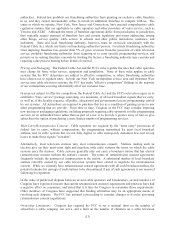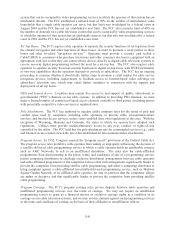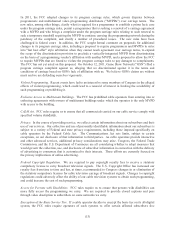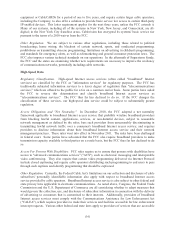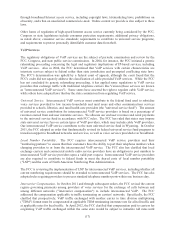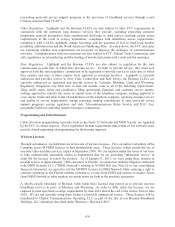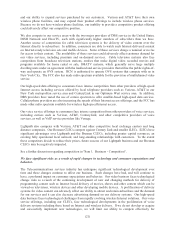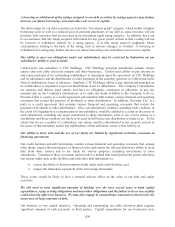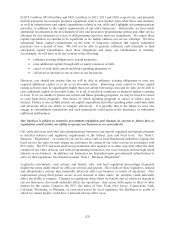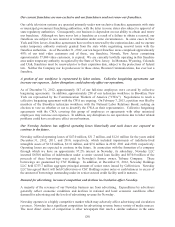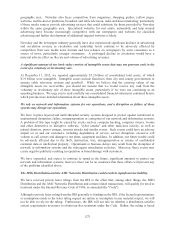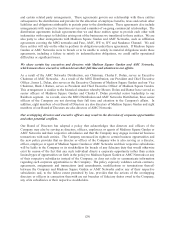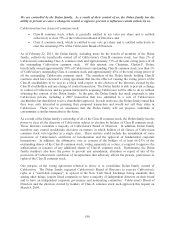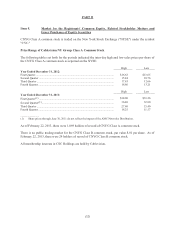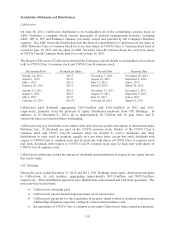Cablevision 2012 Annual Report Download - page 29
Download and view the complete annual report
Please find page 29 of the 2012 Cablevision annual report below. You can navigate through the pages in the report by either clicking on the pages listed below, or by using the keyword search tool below to find specific information within the annual report.(23)
from third parties or reduce or eliminate dividend payments and stock repurchases or other discretionary
uses of cash. However, if such measures were to become necessary, there can be no assurance that we
would be able to sell sufficient assets or raise strategic investment capital sufficient to meet our scheduled
debt maturities as they come due. In addition, any significant reduction in necessary capital expenditures
could adversely affect our ability to retain our existing customer base and obtain new customers, which
would adversely affect our future operating results, cash flows and financial position.
Disruptions in the capital and credit markets can also result in higher interest rates on publicly issued debt
securities and increased costs under credit facilities. Such disruptions would increase our interest
expense, adversely affecting our results of operations and financial position.
Our access to funds under our revolving credit facilities is dependent on the ability of the financial
institutions that are parties to those facilities to meet their funding commitments. Those financial
institutions may not be able to meet their funding commitments if they experience shortages of capital and
liquidity or if they experience excessive volumes of borrowing requests within a short period of time.
Moreover, the obligations of the financial institutions under our revolving credit facilities are several and
not joint and, as a result, a funding default by one or more institutions does not need to be made up by the
others.
Longer term, volatility and disruptions in the capital and credit markets as a result of uncertainty,
changing or increased regulation of financial institutions, reduced alternatives or failures of significant
financial institutions could adversely affect our access to the liquidity needed for our businesses. Such
disruptions could require us to take measures to conserve cash until the markets stabilize or until
alternative credit arrangements or other funding for our business needs can be arranged.
We have substantial indebtedness and we are highly leveraged, which reduces our capability to
withstand adverse developments or business conditions.
We have incurred substantial amounts of indebtedness to finance operations, to upgrade our cable plant
and acquire other cable television systems, sources of programming and other businesses. We also have
incurred substantial indebtedness in order to offer our new or upgraded services to our current and
potential customers and to pursue activities outside our core businesses such as our acquisitions of
Clearview Cinemas, Newsday, an electronics retailer and our development of Rainbow DBS. In 2006,
CSC Holdings incurred $3.5 billion of debt, approximately $3.0 billion of which was distributed to
Cablevision to fund a $10 per share dividend on its common stock and approximately $414 million of
which was used to repay existing indebtedness, including interest, fees and expenses. In December 2010,
we incurred approximately $1.4 billion of indebtedness to finance our acquisition of Bresnan Cable. We
may continue to incur substantial amounts of debt in the future. At December 31, 2012, our total
indebtedness aggregated approximately $11.0 billion. Because of our substantial indebtedness, we are
highly leveraged and we will continue to be highly leveraged. This means that our payments on our
borrowings are significant in relation to our revenues and cash flow. This leverage exposes us to
significant risk in the event of downturns in our businesses (whether through competitive pressures or
otherwise), in our industries or in the economy generally, because although our cash flows would
decrease in this scenario, our required payments in respect of indebtedness would not.
We have in past periods incurred substantial losses from continuing operations, we have a significant
stockholders' deficiency, and we may in the future incur losses from continuing operations which
could be substantial, which may reduce our ability to raise needed capital.
We have in the past reported losses from continuing operations and we may do so in the future.
Significant losses from continuing operations could adversely affect our ability to comply with the
covenants and restrictions in our debt agreements and could limit our ability to raise needed financing, or
to do so on favorable terms, as such losses could be taken into account by potential investors, lenders and
the organizations that issue investment ratings on our indebtedness.


